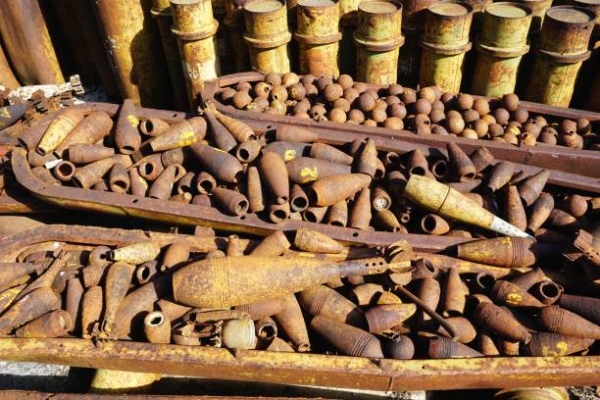What are cluster munitions?
Launched from the ground or dropped from the air, cluster munitions are large weapons made up of a hollow shell containing dozens or hundreds of smaller explosive submunitions. They are designed to break open in mid-air, releasing the submunitions and saturating an area that can be as wide as several football fields, posing a humanitarian threat both during and after attacks, since they can explode even after months or years. Cluster munitions are area-effect weapons, which means that their impact is not limited to one precise target, indeed, often a whole area is scattered with explosives, and anybody within the targeted area is very likely to be killed or seriously injured. Furthermore, since the explosive submunitions are not precision-guided, weather and other environmental factors can affect their accuracy.
How are they affecting civilians?
Because the submunitions cannot distinguish between combatants and civilians, cluster munitions used in populated areas almost inevitably kill or injure civilians.
Many explosive submunitions, also known as bomblets or “duds”, that fail to detonate as designed when they are dispersed, become de facto landmines, endangering people for months or years after the conflict has ended and creating barriers to socio-economic development. Indeed, unlike the initial blasts, the effects of unexploded submunitions are more discriminate, killing almost exclusively civilians. The research program “Cluster Munition Monitor”, recorded that the total number of cluster munition casualties to date has reached 86,000, as calculated from various country estimates. Since 2008, the countries with the highest recorded numbers of cluster munition casualties are Laos (7,755), Syria (3,580), and Iraq (3,070).
What is the international community doing about it?
To protect civilians from the effects of cluster munitions, in 2007, the civil society grouped under the Cluster Munition Coalition, together with some United Nations Agencies and other countries led by Norway, initiated the Oslo Process, which resulted in the adoption of the Convention on Cluster Munitions in 2008. The Convention bans the use, production, stockpiling, and transfer of these weapons. It also requires state parties to destroy stockpiled cluster munitions, to clear contaminated areas, and to assist victims.
To date, 123 states have committed to the goals of the Convention, and most states that have not joined the convention have never used cluster munitions. However, Israel, Russia, and the United States, which are known to be major users and producers of cluster munitions, are neither states parties nor signatories.
Nevertheless, the Second Review Conference of States Parties to the Convention on Cluster Munitions will be held between the 2nd and 3rd June. Ahead of the first part of the Review Conference, the Lausanne Declaration - which includes the condemnation of the use of cluster munitions by any actor under any circumstances” - has been disseminated. At the conclusion of the Second Review Conference, states should adopt that declaration in order to help each other to fulfill their obligations under the convention.
Sources:
https://humanitariandisarmament.org/issues/cluster-munitions/
https://reliefweb.int/sites/reliefweb.int/files/resources/Cluster%20Munition%20Monitor%202020.pdf
http://www.the-monitor.org/en-gb/the-issues/cluster-munitions.aspx
http://www.stopclustermunitions.org/en-gb/home.aspx
https://www.clusterconvention.org/
https://www.hrw.org/news/2021/04/19/case-condemnation
https://undocs.org/en/ccm/conf/2020/wp.1
Author: Eleonora Gonnelli




